THE DRIVE ON PRUEM
The drive on Prüm
29 January – 14 February 1945
Prelude
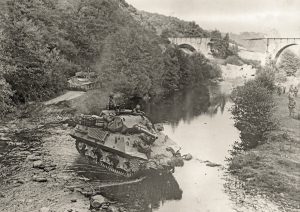
As early as September 1944, the first battle in the Schnee-Eifel region occurred. As the Allied forces dashed through France, Belgium and Luxembourg in the summer of 1944, the US 4th Infantry Division was one of the first units to cross the German border at the village of Hemmeres on September 11th at 2130h. Three days later the division found itself confronting the German Siegfried line fortifications on the Schnee-Eifel heights, where fierce German resistance and counterattacks denied them further excess into Germany. After the main focus of the Allies had shifted to other areas, a static front took over as autumn made its entry. Friend and foe dug in, were resupplied, and finally divisions were replaced by other divisions. Until the 16th of December arrived, which is history. In an effort to turn the tide, the Germans launched an all-out assault on the west front, known as the Battle of the Bulge. The Schnee-Eifel and the town of Prüm served an essential, strategic role. For logistical reasons the town of Prum possessed a rail and expended road network. The Schnee-Eifel, with its large forested area called Schwarzer-Mann, was the spot where the front-line was, and thus the starting point of the offensive. Also this dense forested area absorbed a large part of the defending American forces in this region. As the German artillery barrage lifted on the early morning of December 16th the Germans attacked. Defending the area was the US 106th Infantry Division, this unit just arrived on the front-line a few days prior to the attack. With no battlefield experience the Americans did what they could against an overwhelming strength of German Volksgrenadier, Fallschirmjäger and SS troops. Despite the tough resistance of the American defenders, the outcome would result in the highest loss in American military history. In total two infantry regiments (7000 men) were trapped in the Schnee-Eifel sector and were forced to surrender in the vicinity of Schönberg. As the German offensive dragged further to the west while the days in December continued, the new year brought a positive turn in the events. From France, General Patton’s Third Army had been ordered to halt their advance in the region of Metz and turned north to relieve the Americans trapped at Bastogne, and futher reduce the German Bulge from the southern flank. As January continued good progress was made, although at a heavy price. By the end of the month almost the entire frontline of 16 December 1944 was again restored.
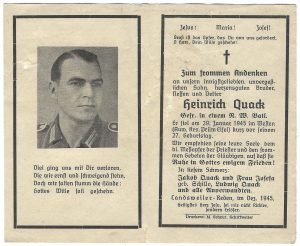
With the Third US Army now in command of clearing the Eifel, the VIII Corps under the command of General Middleton was appointed to clear the Schnee-Eifel sector of Germany and take the strategic town of Prüm. The objective of Prüm was obvious, if this town could be taken the road to the east and finally to the Rhine lay open. But the town lay tucked away behind the Siegfried line, which first had to be overcome. Spearheading the attack was the US 4th Infantry Division. Previously the 4th Infantry Division fought a dreadful battle in the Hürtgen forest where it sustained heavy losses in November 1944. Finally in December it was sent to the south of Luxembourg for rest when it was hit by the German Ardennes offensive, however it could rapidly halt a German breakthrough in this sector without to many losses. Now, by the end of January 1945, it had travelled with Patton’s Third Army back through Belgium and Luxembourg and found itself in the same area where it attacked five months earlier in September 1944, with the same objectives awaiting them. The 4th Infantry Division was accompanied by the 87th Infantry Division on the left flank and the 90th Infantry Division on the right and with the 11th Armored Division in reserve. As the Americans caught the Germans with their pants down, good progress was made while entering Germany for that second time.
On January 29, the VIII Corps attack into German territory began from the direction of Burg Reuland and Schönberg in Belgium, which by then were back in US hands because the Germans were forced to withdraw from the bulge earlier that month. Opposite the VIII Corps only light to moderate resistance was encountered from remnants of the 326th and 276th Volksgrenadier-Division when the Americans captured the first line of German villages on the west slope of the Schnee-Eifel (Schwarzer-Mann) ridge. With the first villages like Winterspelt, Bleialf and Auw back in American hands on the 3rd of February 1945, the VIII Corps had established a foothold into Germany and thus a favorable position to launch its assault against the Siegfried line.
The plan

Appointed to spearhead the assault was the 4th US Infantry Division. The division consisted of three infantry regiments, the 8th, 12th and 22nd. These regiments were also called Combat Teams, in short “CT” (CT8, CT12, CT22). Each regiment or CT had three battalions, each battalion could count on four companies. Committed for the attack against the Siegfried line was the 8th and 22nd Regiment, the 12th would stay in reserve after it had captured the small town of Bleialf two days before. The offensive plan was as follows, the attack would lead from the town of Bleialf towards the Schnee-Eifel / Schwarzer-Mann ridge on the 4th of February. CT8 would advance on the left flank, over the west slope of the Schnee-Eifel heights, and capture the pillboxes in this area and take the main road running over the Schnee-Eifel in a north to south direction (todays L20) and finally break through the dense forested area in a eastern direction and take vital positions and villages east of the Schnee-Eifel. CT22 was to attack over the road exiting Bleialf in an eastern direction. It was to capture the crossroads of Meisert / Brandscheider Kreuz before it would swing to the south and take the village of Brandscheid itself. If the crossroads and Brandscheid were taken it could move further to the east and take Sellerich and Niedermehlen before it was in favorable positions to attack the town of Prüm.
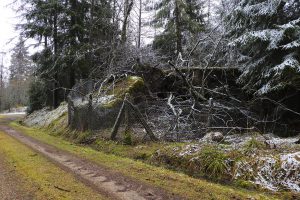
On the 4th Infantry Division’s right flank the 90th Infantry Division would take Habscheid, and proceed towards Pronsfeld. The 87th Infantry Division, on the left, would clear the Siegfried line in the northern tip of the Schnee-Eifel ridge and take the northern crossroads and from there it would attack the town of Olzheim situated north of Prüm, along the Prüm river. This town was to be a strategic location for further operations.
As the German units concerned, it was presumed, that around seven infantry divisions, and about three panzer divisions would face the American attack in the VIII Corps center. However this sounds like quite a number, the German divisions were all previously engaged in the Ardennes offensive and had suffered immense losses there. It was estimated at this time that each German infantry division would count around 1000 men strong, instead of the normal 12.000 a 15.000 men. The three panzer divisions in the VIII Corps center had something in the range of 70 tanks and assault guns left, all three divisions combined. What also must be mentioned is that some of German divisions were put in rear positions for rebuilding, for instance the 5th Fallschirmjäger-Division under the command of General Heilmann was pulled off the frontline and was regrouping in the Duppach / Schwirzheim / Lissendorf sector. Also the 2nd Panzer-Division under the command of Oberst Lauchert was put in a reserve position at Nieder- and Oberkail to the south. A second major disadvantage for the Germans was that their Army boundaries of the 5th Panzer Army and 7th Army lay exactly in the middle of where the Americans would attack, the boundary line laid somewhere between Prüm and Pronsfeld. With this the result was that only small numbers of men were deployed at this line and actually nobody wanted to take responsibility for this sector.
February 4th, the attack
Although the 4th US Infantry Division’s attack towards Prüm was scheduled in the early hours of February 4th, earlier at night time a reinforced platoon of CT8 on a patrol mission found the first line of bunkers in the Schnee-Eifel ridge unoccupied. With this knowledge the Division commander, General Blakeley ordered an instant attack towards the Schnee-Eifel before the Germans could re-occupy their positions. By now, at 0600h the 1st Battalion of CT8 together with the 1st Battalion of CT22 were moving east of Bleialf to attack. 1-CT8 reached the road on top of the Schnee-Eifel ridge early in the day and didn’t meet any major opposition from the German defenders. With the Schnee-Eifel road now already in possession at the end of the morning, the two battalions were to move in a north and southern direction and clear the pillboxes which were located parallel along the Schnee-Eifel road in this sector. The attack was successful and the few German units defending the pillboxes were no match for the advancing Americans. During the day around 130 prisoners were captured. By nightfall 1-CT22 had advanced just in front of the Brandscheider Kreuz crossroads north of the village of Brandscheid. Seizing the crossroads was to be postponed for the next day.
February 5th, Brandscheid

In the early morning hours of the 5th of February the attack towards the crossroads of Meisert began. But just as in September 1944, the Americans, consisting of the 1st Battalion, CT22 encountered stiff resistance from the German defenders of the 326th Volksgrenadier-Division, also mortar and artillery fire was received at the crossroads. It took the battalion all morning to clear the area and when they were finally successful an attack towards the village of Brandscheid could be made. This village was baptized with the name “Westwall Village” and it is no surprise that this was the strongest point of the Siegfried line in this sector. The September battles had left the village in ruins but still in German hands. Five months later the Americans would try their luck again. In the early afternoon the attack started off from the woods north of the village and into the open terrain. The attack was accompanied by Sherman tanks and tank destroyers who fired point blank on the many pillboxes in the area. The American attack was successful and they advanced fast. Three hours later and against only light opposition Brandscheid finally fell into their hands, after sustaining only minor casualties.
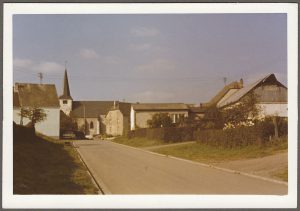
To the north, in the area of CT8, the advance on February 5th also resulted in success, they were able to clear more pillboxes along the Schnee-Eifel road without any serious opposition. However the more the day and advance proceeded the stiffener the German opposition became. Around the end of the afternoon the 1st Battalion wasn’t able to advance further.
With the day coming to an end, the 326th Volksgrenadier-Division’s front in the Schnee-Eifel sector and at Brandscheid had totally collapsed. Thus the German high command was aware that the situation was forming a big threat to the town of Prüm. The German LXVI Corps commander, General Lucht ordered the remnants of the 276th Volksgrenadier-Division and several other alarm units to stop any further penetration of the Americans the next day. Also the strategic village of Brandscheid should be taken back at all costs.
February 6th, counterattack at Brandscheid
While on the 6th of February, the 90th Infantry Division’s attack on Habscheid began, the 4th US Infantry Division was facing more opposition by the hour. When in the night of February 5/6 elements of CT22 were just about to be relieved in Brandscheid by elements of the 358th Infantry Regiment of the 90th Infantry Division, the German reinforcements attacked. The 450 men strong attack consisted of soldiers of the Engineer Battalion of the 326th Volksgrenadier-Division and by artillery soldiers of the 14th Werfer-Regiment. The German timing was perfect, and they were able to break through the frontline held by K Company south of Brandscheid and were able to penetrate into the village. It took L Company of CT22, that was actually just relieved, to drive the Germans back out of Brandscheid. 160 prisoners were captured and late in the morning Brandscheid was firm in US hands, although at a high price.
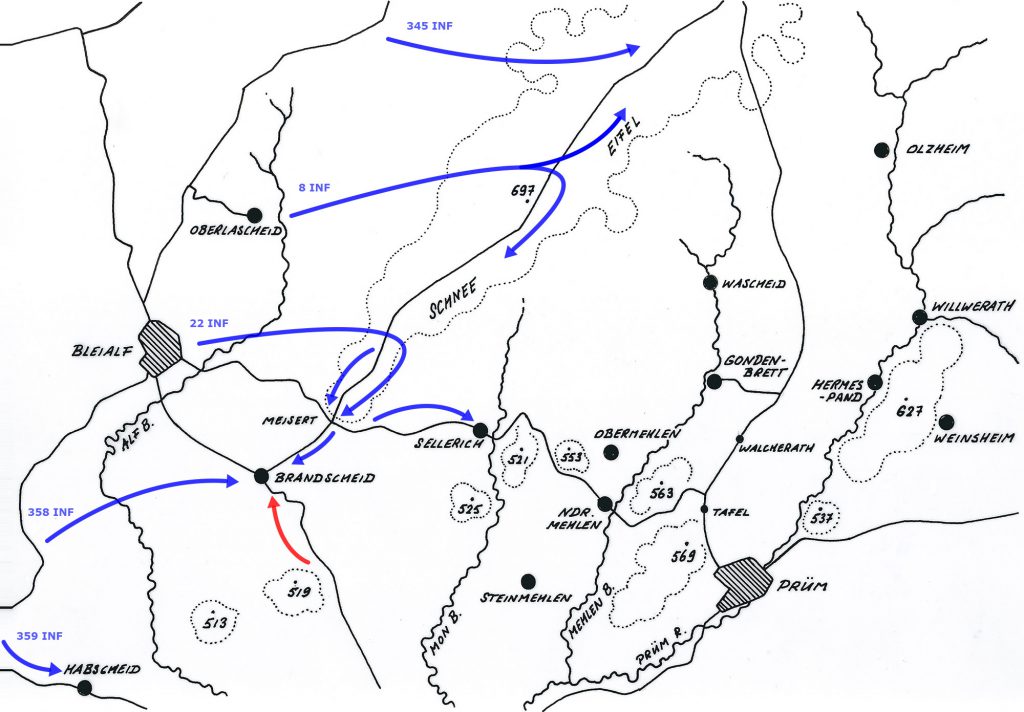
With Brandscheider Kreuz and with Brandscheid itself now in firm hands by CT22 and the 358th Infantry Regiment, the attack of CT22 towards the east which was scheduled for the morning had to be postponed till afternoon. The attacking force consisted of two battalions moving out from the area of Meisert at 1205h. The attack followed in an eastern direction through the woods of the Schnee-Eifel and in the open terrain just in front of the villages of Sellerich and Hontheim. The 326th Volksgrenadier-Division now crippled through the previous counterattack couldn’t bring in much against the Americans and the town of Hontheim fell in the hands of the 2nd Battalion around 1745h. The 1st Battalion’s attack had started 5 minutes before the 2nd Battalion’s attack and in the late afternoon they were able to capture the villages of Sellerich and Herscheid against only light opposition.
February 7th, breaking out to the east
In an aid to help the 22nd Infantry Regiment’s advance towards Prüm, two regiments of the 90th Infantry Division, the 357th and 358th were assigned to proceed from the Brandscheid held area to the south east through the forest of Helmert, near Herscheid. Thus advance in the direction of Prüm from a more southern route. The advance met only light opposition and the hill of Helmert was taken fast by the 3rd Battalion of the 358th Infantry Regiment. On the other hand the 2nd Battalion’s advance to the south of Brandscheid wasn’t that successful. It met fierce opposition from German pillboxes in their sector. Also in the 1st Battalion’s sector opposition was met but with the help of tank destroyers it found a way to clear 10 pillboxes during the 7th of February, and take a large number of Germans prisoner.
Still meeting fierce opposition from the south of Brandscheid and hill 519, the 3rd Battalion of the 358th Regiment was sent from its position at hill 521 in a south western direction to knock the Germans off the heights south of Brandscheid. With no covered route to approaching hill 519 the battalion commander asked for delay and armored reinforcements. During the late afternoon several patrols were sent out to find a good approach route to their objective. All patrols ran into heavy small arms fire from the Germans and were forced to retreat with casualties. Later I Company tried to capture the hill but as soon as they were in the open terrain a hail of bullets and mortars rained down of them, forcing them to return to their original positions and abort the attack as well.
The same day to the north, CT8 of the 4th US Infantry Division had won some reasonable amounts of ground. No fierce opposition was met and the attacking companies were able to work their way down the wooded Schnee-Eifel ridge in the vicinity west of Wascheid, where only light resistance was met. But as the regiment moved against Gondenbrett the resistance increased considerably.
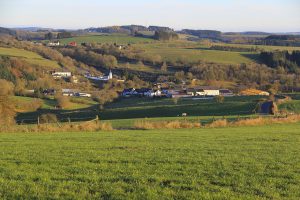
In the sector of CT22 at Sellerich and Hontheim things were different. They had reached well behind the Siegfried line defenses by now, but were troubled by several counterattacks which the Germans had thrown at them. With the Americans now standing only a few miles before their main objective Prüm, the Germans sent in more reinforcements to oppose them. Elements of the 5th Fallschirmjäger-Division which were licking its wounds sustained in the battle of the Bulge in an rest area near Lissendorf, were sent to face CT8 at Wascheid and Gondenbrett. The once formidable 2nd Panzer Division, which was only a skeleton of the unit it once was after the battle of the Bulge, was sent directly west of Prüm to oppose the 22nd Infantry Regiment’s attack. One of the counterattacks aimed at CT22 in Sellerich consisted of remnants of the 276th Volksgrenadier-Division, the attack came from the direction of Steinmehlen but was successfully repulsed. As the Americans advanced further to the west they were able to take the dominating high ground east of Sellericher Höhe, the so called “Am Kopf” hill (553) which dominated not only the villages of Sellericher Höhe and Obermehlen, but also the road leading towards Niedermehlen and eventually Prüm. Immediately two German counterattacks reinforced with tanks leading from Obermehlen and from Niedermehlen were able to knock the Americans off the “Am Kopp” hill but not for long. After the Germans had taken back the hill a reserve company of the CT22 was thrown into the attack and knocked the Germans off again, this time for good. Not much later, to the northeast, the 2nd Battalion was able to enter the village of Obermehlen and occupy it partly. But also at Obermehlen an counterattack was met. The Germans who attacked were reinforced by three tanks from the 304th Panzergrenadier-Regiment (2nd Panzer-Division) which had just arrived from its resting area at Ober and Niederkail. Against the odds the Americans in Obermehlen held out, and with the aid of some tank destroyers the German attack was repulsed.

Around the same time to the southwest the 1st Battalion had been able to cross the small Monbach creek that ran through to villages of Sellerich and Hontheim to the south. The men of the 1st Battalion ran into stiff German resistance as they climbed up the Knieberg hill (521) on the eastern bank of the creek. Other crossings over the Monbach creek further to the south only meant more opposition. At Warmendell the Germans were well entrenched and from the vicinity of Steinmehlen the 1st Battalion was struck by several small counterattacks.
By now the regimental commander of CT22 ordered the 3rd Battalion to move in behind the 2nd at Obermehlen to take some weight off their shoulders. The battalion was bowed down under counterattacks the entire day.
In the afternoon of the 7th of February the 1st Battalion of CT8 moved out in force against Gondenbrett, but met stiff resistance in and around the village from the Engineer Battalion of the 5th Fallschirmjäger-Division. Nonetheless the Americans succeeded in entering the outskirts of Gondenbrett. An hour later, the 2nd Battalion of CT8 set in their attack against Wascheid. For a change no opposition was met and the village was captured.
The arrival of the German 2nd Panzer-Division and 5th Fallschirmjäger-Division, during this day, was an result of an decision made by Generalfeldmarschall Model to shift the boundary between the 5th Panzer Army and 7th Army further to the north. This to solve the problem that the Germans were facing with the American counterattack exactly in the middle of their boundary lines, and thus weakest point. The boundary was now shifted somewhat north towards the town of Stadtkyll. And the defense of Prüm was now the task of the 7th Army, more precisely that of the XIII Korps which fell under the command of General Felber. Which explains the arrival of new units like the 2nd Panzer-Division and 5th Fallschirmjäger-Division in the Prüm sector.
February 8th, crossing the Mehlenbach creek and the capture of Gondenbrett
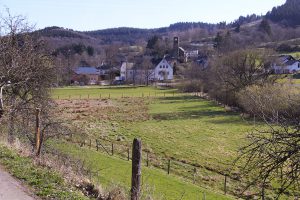
With the German army boundaries now shifted, new German units opposed the US 4th and 87th Infantry Division. But also on the American side the front was moving. In the north the 345th Infantry Regiment of the 87th Division was able to break through the dense Schnee-Eifel forest, and had captured the town of Olzheim, although a high number of casualties in men and officers had to be paid. Due to the breakthrough at Olzheim the newly arrived German 5th Fallschirmjäger-Division positioned its 14th Regiment in and near the village of Willwerath to protect the 2nd Panzer and 5th Fallschirmjäger-Division’s right flank. It is assumed that remnants of the 13th Fallschirmjäger-Regiment lay opposite Olzheim in the town of Kleinlangenfeld, although reports also mention the presence of the 9th Panzer-Division in this vicinity. The German frontline east of Wascheid was held by the 15th Fallschirmjäger-Regiment, south at Gondenbrett the 5th Fallschirm-Pionier-Bataillon (Engineers) firmly held a large part of the village which they defended fanatically against the 1st Battalion of the 8th US Infantry Regiment throughout the day. In Wascheid the 2nd Battalion of CT8 was relieved by the 3rd Battalion around afternoon.
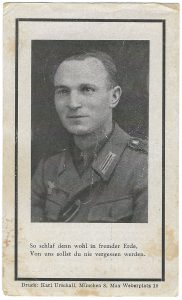
With the 2nd Panzer-Division’s arrival in the sector of CT22 the opposition from the enemy increased every hour. Again Obermehlen was the target of two German counterattacks in the early morning on the 8th of February, a third counterattack was aimed at the “Am Kopp” hill but all three attacks were successfully repulsed. But by means of counterattacking the Germans were able to delay any further advance in the 22nd Regiment’s sector. And it wasn’t until around late afternoon that the 2nd and 3rd Battalions finally could start their attack that was actually scheduled for in the morning. The battalions moved in slowly but were able to clear the last enemy occupied houses in Obermehlen and moved in towards the open ground south of the village. After the open ground south of Obermehlen was also secured the 2nd Battalion set in to cross the Mehlenbach creek east of Obermehlen and occupy the high ground on the other side of the creek, the so called “Weinschiedsberg” or hill 563. After these two objectives were reached the battalion was to clear the area near Tafel, a small hamlet located just before Prüm. It was suspected that this was the area from where the German counterattacks had come. Although the Mehlenbach creek is in the summer is a small and quiet waterway, melted snow and heavy rains had as result that the creek broke through its embankments and was at some places 5 meters in wide and thus was forming a major obstacle for the attacking battalion on foot. To find a way to reach the other side of the creek dry, several makeshift fords and bridges of logs were made to cross it, but at the end most of the men reached the other side soaking wet and cold.
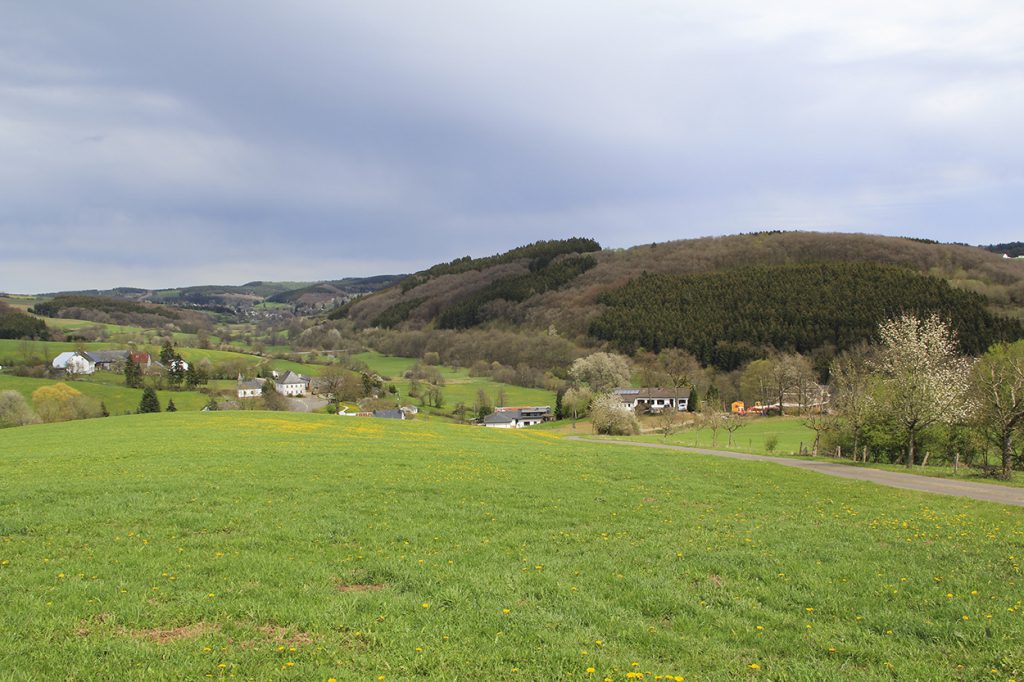
In the 2nd Battalion’s sector, G Company had been able to cross the creek without any opposition. But as soon as the heavy weapons platoon tried to cross the creek further to the south it was fired upon by an well positioned machine gun from the vicinity of Niedermehlen. The enemy fire inflicted a high number of casualties. There the heavy weapons platoon wasn’t able to cross the river due to the enemy machine gun fire south of their position, the men of G company were without heavy weapons and bazooka’s. Nonetheless G Company would stay on the east side of the creek and had already advanced halfway up the hill 563. But as soon as the men had started digging in a company of the 2nd Panzer-Division attacked. The German attack was supported by five tanks and without any anti-tank weapons the American defenders didn’t stand a chance, and were forced to pull back again on the west side of the Mehlenbach creek. Any other attempts by CT22 to cross the creek were postponed.
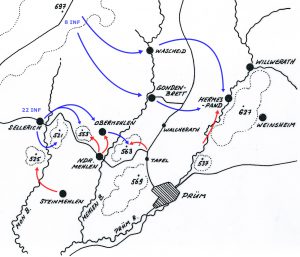
Late on the 8th of February, in the hours of darkness the 1st Battalion of CT8 had scheduled an surprise attack against the German held part of Gondenbrett. As the 5th Fallschirm-Pionier-Bataillon was caught off-guard, the defending platoon in the village was almost entirely captured. After the Americans had secured Gondenbrett it moved through the night in an eastern direction over the heights east of the Mehlenbach creek. Meeting no opposition the advance proceeded rapidly. After reaching the outskirts of Hermespand CT8 was able to secure the village, after facing only light opposition. The Germans alarmed with this changing situation moved the 2nd Battalion of the 2nd Panzergrenadier-Regiment against the Americans in Hermespand in an effort to reestablish contact with the 5th Fallschirmjäger-Division. The Americans, mainly infantry were no match for the German Panzergrenadiers, and they pulled back to positions just west of the village. The strong German patrol moved further up north to reestablish contact with the 14th Fallschirmjäger-Regiment, which was made at the village of Willwerath. Immediately a unit of Fallschirmjäger’s was sent south to Hermespand to defend the village from any further American attacks. But when the Panzergrenadier’s wanted to move through Hermespand again they had found the village back in American hands. For some unknown reason the Fallschirmjäger’s had pulled out and the Americans had seen their chance and captured the village again, including a part of the woods to the east. All this in the late and early hours of February 8/9.
In Brandscheid, on the 8th of February the 357th and 358th US Infantry Regiments of the 90th Division still weren’t able to clear the high ground south of the village. All approaches to this hill lay in the open and no favorable route was to be found. Smoke couldn’t be used due to the wrong direction of the wind and it wasn’t until the late afternoon that the 2nd Battalion of the 358th Infantry Regiment was able to clear some pillboxes in the woods leading up to the hill 519. With an approach route towards hill 519 now cleared the 2nd and 3rd Battalion dug in for a cold night and waited till the next day to attack.
February 9th, Niedermehlen
February 9th meant another long day of hard fighting in the 4th US Infantry Division’s sector, in an effort to reach Prüm now already 5 days had passed, and the casualties in the division were high. However on the north side CT8 was still strong. After the regiment had taken the town of Gondenbrett by an surprise attack the previous night, it was able to reach the heights on the east side of the Mehlenbach creek and there no opposition stood in her way, the regiment had also infiltrated into the village of Hermespand on the Prüm river with her 3rd Battalion. This battalion even occupied a part the wooded high ground east of the Prüm river (Weinsheimer Hardt – hill 627) with I and L Company. In the meantime another force was sent south towards the small village of Walcherath and Tafel, but when the Americans approached these two villages they were fired upon from all directions, and the Americans were forced to postpone the attack.
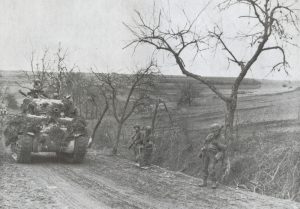
With the Americans now already standing in Hermespand and with all German units heavily engaged, the Schwere-Panzerjäger-Abteilung 506 was sent to fill the gap between the 5th Fallschirmjäger-Division and the 2nd Panzer-Division. Its commander Hauptmann Heiligenstadt, together with his adjutant drove up to reestablish contact with the Fallschirmjäger-Division. However they must have underestimated the American strength and point of advance, or they weren’t informed of the situation correctly because they never came back and were captured during their reconnaissance mission. In an effort to free Hermespand from the occupying Americans, the 1st Battalion of the 2nd Panzergrenadier-Regiment together with an Alarm-unit was sent over from Gondelsheim towards Weinsheim to prepare for an attack on the Hermespand bridgehead and the Americans on Weinsheimer Hardt (627), the hill east of the village. Further to the south, elements of the 2nd Battalion of the 2nd Panzergrenadier-Regiment together with six Tiger tanks of the Schwere-Panzerjäger-Abteilung 506 assembled east of Dausfeld for an attack towards Hermespand as well. But when the order to attack was given the southern attack leading from Dausfeld bogged down in mud. The 1st Battalion attack from Weinsheim wasn’t able to move in close because of the thickness of the woods, therefore everything was postponed.
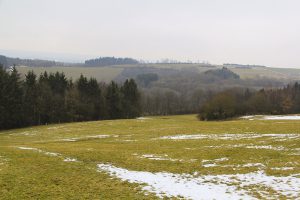
There the previous attack of CT8 aimed at Tafel and Walcherath was repulsed, the task to advance towards Prüm fell again in the hands of CT22. The plan was set, 1st Battalion was appointed to cross the Mehlenbach creek in the vicinity of Obermehlen and advance on hill 563, if these two objectives were reached, it was ordered to move south and seize the village of Niedermehlen from the east. At the same time an attack from “Am Kopp” (553) was aimed at the west side of Niedermehlen in an effort to break the German defenses in the village. There engineering equipment couldn’t be brought up, the 1st Battalion of CT22 had to cross the Mehlenbach creek again by use of fords and logs. As the attack started, two companies: A and C made it across the creek safely without any opposition, but when B Company was ready to cross the creek it came under machine gun fire positioned further south in the valley somewhere in the vicinity of Niedermehlen. In the next few hours of the morning 15 men fell while trying to cross the makeshift bridge across the Mehlenbach creek. But with A and C Company across the creek, the two companies were able to move in fast on hill 563 and were able to secure it an dug in along the slope. But with no decent supply route over the Mehlenbach creek, the men of A and C Company were basically cut off from reinforcements. The Germans aware of their advantage moved in two companies supported by five tanks against the American defenders on hill 563. At the same time Obermehlen lay under continues fire which prevented the 2nd Battalion to help the men from A and C company now trapped on the “Weinschiedsberg”, hill 563. The German counterattack moved in hard and fast, but thanks to the 4th US Division’s artillery the German infantry could be held off. After the counterattack two of the five German tanks were knocked out by close bazooka fire in front of the A and C Company’s foxholes.
On the other side of the creek the 3rd Battalion was supported by armor and the attack towards Niedermehlen started off from their positions at “Am Kopp”. In an attempt to push into the village the attack bogged down under continues fire from the German defenders supported by three assault guns of the 304th Panzergrenadier-Regiment, ending the attack almost as soon as it had begun. An second attempt was made towards Niedermehlen just shortly after the first. At this time the 3rd Battalion was reinforced by the 2nd Battalion and after a tremendous artillery bombardment the German defenses in Niedermehlen collapsed, and the Americans finally moved into the village, capturing about 100 Germans prisoner.
Earlier on the 9th of February, the 4th US Infantry Division’s commander, General Blakeley ordered the 12th Infantry Regiment, which had stayed in reserve the whole time during the advance towards Prüm to move in the line as well. CT12 was ordered to take over the right flank of the 22nd Regiment and took positions somewhere in the vicinity of Herscheid and Sellerich. It was ordered to attack the village of Steinmehlen, but the village was defended by an estimated force of two enemy companies and the objective couldn’t be taken. Around 1630h a German counterattack consisting of about 200 men started off from Steinmehlen into the sector of CT12 but it was repulsed, inflicting countless losses on the German side.
February 10th, Prüm is in sight
With CT8 already on and across the Prüm river at Hermespand, it formed a serious threat for the Germans defending Prüm. The 2nd Panzer-Division’s attack the previous day had met no result, and therefore a combined force of the 1st Battalion of the 2nd Panzergrenadier-Regiment and two alarm companies attacked the American units in the woods east of Hermespand from the direction of Weinsheim. The battle in the forest of Weinsheimer Hardt continued all day, but the Americans were able to hold out. However the pressure on the two American companies east of the Prüm river became so tense, that around midnight order was given to evacuate them back towards Hermespand itself. As the tired and exhausted men descended hill 627 in the hours of darkness, the Germans slowly took over, leaving the hill of Weinsheimer Hardt in firm hands of the 2nd Panzer and 5th Fallschirmjäger-Division.
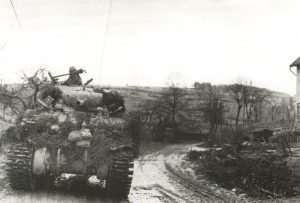
In the 22nd Regiments sector, the village of Niedermehlen, was now well secured and an advance towards Tafel was put in order. The march towards Tafel went without difficulty but when the 1st Battalion reached the outskirts of the small village somewhere in the vicinity of Wirbelscheid, they received heavy small arms fire and progress was made slowly, every meter was fought for bitterly and close combat was the order of the day. Also from the north elements of CT8 were now attacking the crucial crossroads at Tafel, their attack led along the Gondenbrett road and through the woods towards Walcherath. The Americans were attacking in all force now from two directions, and the Germans of the 2nd Battalion, 2nd Panzergrenadier-Regiment bowed under the overwhelming strength and were forced to abandon their positions at Walcherath and retreat towards the wooded area of Tettenbusch, just north of Prüm. The German defenders of Tafel, which consisted of elements of the 304th Panzergrenadier-Regiment which had defended Niedermehlen the previous day, now lay under attack by elements of the CT22 and CT8, and where forced to flee towards the hill of Kalvarienberg (569) west of Prüm, where the fighting’s continued. From Niedermehlen the 3rd Battalion of CT22 joined in at the battle for Kalvarienberg, and the hill overlooking the town of Prüm was finally taken by the end of the day.
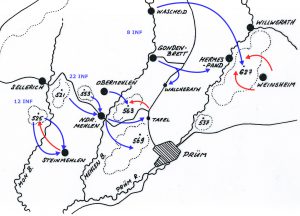
On the 10th of February CT12 finally cleared the village of Steinmehlen with her 1st Battalion against only light opposition made up by remnants of the 304th Panzergrenadier-Regiment, and was now moving on towards Niederprüm.
In the 90th US Infantry Division sector at Brandscheid, an attempt to capture hill 519 was met with fierce resistance from trenches and pillboxes the previous days. And it wasn’t until the 22nd Infantry Regiment had driven the Germans back towards Prüm that the German occupants of hill 519 and the surrounding area voluntarily gave up their positions and fled towards the south and towards the Prüm river in the vicinity of Niederprüm. As a result the way towards the Prüm river finally laid open for the attacking regiments of the 90th US Infantry Division. The village of Weinsfeld was captured after a short fight and the 357th and 358th Regiments could move in fast now without meeting any noticeable opposition.
However the German situation to hold Prüm seemed to be a task with no happy ending. The 2nd Panzer-Division’s commander, Oberst Lauchert was ordered to hold the city at all costs. Generalfeldmarschall Model told him that he was personally responsible for the defense of the city.
February 11th, the attack on Prüm
Around 0815h in the morning of February 11th, elements of CT8 just outside Willwerath were attacked by an enemy force of approximately two companies supported by tanks and assault guns, however the attack couldn’t gain any ground and was repulsed after a few hours. Furthermore several tanks and armored vehicles were spotted in the area of Weinsheim, on the opposite side of the 8th Infantry Regiment’s sector. In Hermespand enemy tank fire was received.
When the day began in the 22nd Regiment’s sector, strong Americans patrols had already reached the outskirts of Prüm the previous evening but determined counterattacks had driven them back towards the area of Tafel. With the Americans now secure on the Kalvarienberg (569) west of Prüm they had an excellent observation point from which they could dominate the entire town, and every enemy movement that was spotted was fired upon. During the early morning Prüm laid in a hellish inferno of artillery and aircraft fire. Still the Germans didn’t want to give up the town. Meanwhile in the areas north and south of Prüm all the Germans forces were retreating towards the east side of the river. And around the afternoon the long expected attack of CT22 on Prüm had started. The 3rd Battalion began descending from the Kalvarienberg and as the day ended the west side of the town was as good as free from the enemy.
February 12th, mopping up
With a new daybreak on the 12th of February, the Americans slowly continued to clear the town from the enemy. Bitter house to house fighting’s occurred, but the German troops consisting of exhausted men simply weren’t cut out for the job of defending the town. They made every meter of advance highly paid for, however. The 22nd Regiment´s advance through the town was encountered mainly by snipers and small isolated groups of German defenders who fought from cellars and ruined houses, inflicting a lot of casualties. It took CT22 all morning and around 1320h in the afternoon the regiment reported to the division that Prüm was clear of the enemy.
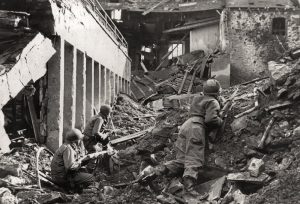
To the north CT8 had taken over the 87th Infantry Division’s positions at Olzheim when it was attacked by an estimated force of at least three companies supported by armor of the 9th Panzer-Division which fired from the heights opposite Olzheim into the village. Also heavy mortar and rocket fire was received all day long, as well as in the village of Hermespand. But around 1200h the German attack had been repulsed and no ground was lost.
Afterface
With Prüm for the larger part now secure in American hands any further advance of the 4th US Infantry Division was canceled and after a long week of fighting the troops got their well-earned rest. Defensive positions were dug in all along the western bank of the Prüm river, and strong patrols were sent out. On the German side everything was quiet as well, and they also were digging in all along the Prüm river. Not much activity on the enemy’s side was spotted. On the 13th of February a small troop of about 25 Germans counterattacked Prüm from the north but the attack was pointless, and was repulsed.
Although many US reports indicate that Prüm fell on the 12th of February it’s a fact that some isolated German units held out until the 14th. But on the other side the German “Wehrmachtsbericht” reported that until February 15th, 1945 heavy house to house fighting’s occurred in the city, and all American attacks were repulsed. A nice example of propaganda from both sides.
Around the 14th of February, the positions of the 2nd Panzer-Division east and south east of Prüm were taken over by the 14th Fallschirmjäger-Regiment and by elements of the 340th Volksgrenadier-Division. And the 2nd Panzer-Division was sent further south to occupy positions towards Bitburg, and with this ending the drive towards Prüm.
